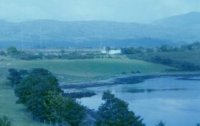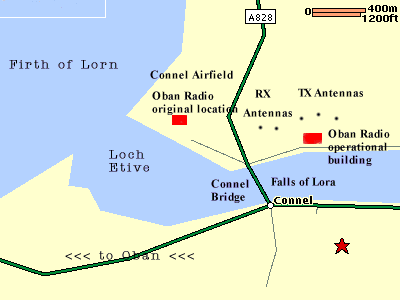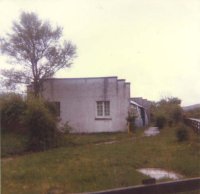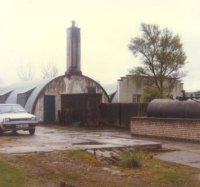A SHORT HISTORY OF
OBAN RADIO/GNE
 Oban
Radio was established in 1949 following pressure from the fishing industry
for better coverage of Scotland's North Western coastline. Until then,
the nearest UK Coast Radio Stations were at Portpatrick and Wick. Although
one other Coast Radio Station also covered the area, Malinhead
Radio was not counted in the equation because, being in
the Irish Republic, it was counted as foreign! Oban
Radio was established in 1949 following pressure from the fishing industry
for better coverage of Scotland's North Western coastline. Until then,
the nearest UK Coast Radio Stations were at Portpatrick and Wick. Although
one other Coast Radio Station also covered the area, Malinhead
Radio was not counted in the equation because, being in
the Irish Republic, it was counted as foreign!
 Initially
the General Post Office (GPO), who were responsible for all maritime
communications matters, purchased the war-time airfield at Connel and
established Oban Radio by placing their mobile emergency coast radio
station at the edge of the airfield. The two original Radio Officers
at the new station, Donald Morrison and Sam
Kennedy, served out their time there until they retired. Initially
the General Post Office (GPO), who were responsible for all maritime
communications matters, purchased the war-time airfield at Connel and
established Oban Radio by placing their mobile emergency coast radio
station at the edge of the airfield. The two original Radio Officers
at the new station, Donald Morrison and Sam
Kennedy, served out their time there until they retired.
Light aircraft still occasionally used the airfield and,
because sheep roamed freely over the area, the pilots would alert the
operators by telephone before making the flight, giving them an ETA.
On arrival over Connel the aircraft would over-fly the field to alert
the station officers of their arrival at which point the officers would
chase the sheep off the runway to allow safe landing of the aircraft.
(Right up until closure of the station in 1982, requests to clear the
sheep were still received at Oban Radio - this request was then passed
on to the owner of the sheep!)
Plans were laid to construct a permanent, futuristic operating
building for Oban Radio. This was to include provision of 150 feet vertical
transmitter masts with associated earth mats. When the local community
got wind of the proposals, and realised that the tall masts were to
be in the middle of the airfield - effectivly closing the field - there
was an outcry. "The airfield was essential to the lifeblood of
this highland community" they argued - and, at the end of the day,
they won the argument. Oban Radio's new building was shelved (the same
building design was constructed for Angelsay, Ilfrcombe and Stonehaven
radio stations) and the station was back to square one in the emergency
coast radio station.
 Eventually
the GPO purchased what had been RAF accomodation, still in North Connel
but about a mile eastward of the airfield. About two years after the
station first came on air, the RAF's nissan huts became the "temporary"
permanent home for Oban Radio for the remainder of it's operational
life. The tall transmitter masts were erected in fields outside the
station building with receiver masts in another field in the moss adjacent
to the Fort William road. Eventually
the GPO purchased what had been RAF accomodation, still in North Connel
but about a mile eastward of the airfield. About two years after the
station first came on air, the RAF's nissan huts became the "temporary"
permanent home for Oban Radio for the remainder of it's operational
life. The tall transmitter masts were erected in fields outside the
station building with receiver masts in another field in the moss adjacent
to the Fort William road.
Initially Oban Radio only provided a radio-telephony service,
principally monitoring the 2182kHz distress frequency, and could accept
and deliver radio-telegrams for ships. Later a wireless telegraphy (WT/Morse
Code) service was added in the 1.6MHz trawler band where, in conjunction
with other Coast Radio stations, a service was provided to the United
Kingdom's substantial middle and distant waters trawler fleet. Very
much later, the facility to provide shipping with radio-telephone "link
calls" was provided at Oban Radio.
 The
callsign of Oban Radio (with which it identified itself when using Morse
Code) was GNE. This is understood to have been the callsign originally
used by a war-time direction finding station based on the Isle of Tiree. The
callsign of Oban Radio (with which it identified itself when using Morse
Code) was GNE. This is understood to have been the callsign originally
used by a war-time direction finding station based on the Isle of Tiree.
Equipment at GNE was as standard at all the United Kingdom
Coast Radio Stations. A major 1950's re-fit of the stations had provided
them with GPO-built "W5" 3kW peak CW/AM multi-frequency transmitters
with Marconi Electra receivers and all the transmitter control equipment
being installed in purpose-built operating consols. Antennas were vertical
mast radiators with base tuning units and earth mats. Emergency generators
ensured that the station could remain on air even if the public electricity
supply failed.
In the late 1970's a re-equip of Oban Radio removed the
W5's and replace them with 1kW pep single sideband single frequency
SPT Ajax transmitters, once each for 2182kHz, 1792kHz, 1848kHz and 2740kHz
plus an identical transmitter providing CW on 1612kHz. These were backed
up by a 1kW multi-frequency Marconi H1000 transmitter. Four of the Ajax
transmitters fed into one 180 foot vertical broadband radiating latice
mast via a "combiner" unit. One Ajax transmitter had a dedicated
mast radiator as had the H1000, both beig provided with a tuning unit
at the base of the antenna. Receivers became Eddystone EC958's.
|